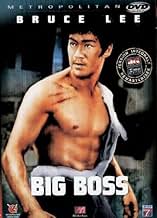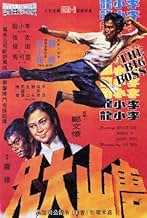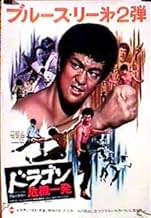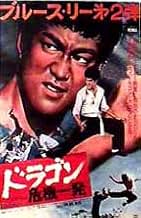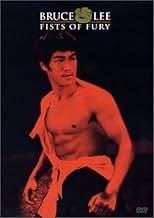IMDb-BEWERTUNG
6,9/10
30.898
IHRE BEWERTUNG
Ein junger Mann, der auf einen Eid der Gewaltlosigkeit geschworen hat, arbeitet mit seinen Cousins in einer Eisfabrik, wo sie auf mysteriöse Weise zu verschwinden beginnen.Ein junger Mann, der auf einen Eid der Gewaltlosigkeit geschworen hat, arbeitet mit seinen Cousins in einer Eisfabrik, wo sie auf mysteriöse Weise zu verschwinden beginnen.Ein junger Mann, der auf einen Eid der Gewaltlosigkeit geschworen hat, arbeitet mit seinen Cousins in einer Eisfabrik, wo sie auf mysteriöse Weise zu verschwinden beginnen.
James Tien
- Hsiu Chien
- (as Paul Tien)
Nora Miao
- Drinkstand owner
- (as Miao Ke Hsiu)
Ying-Chieh Han
- Hsiao Mi (Boss Mi)
- (as Han Ying Chieh)
Hua-Sze Li
- Ah Chai
- (as Li Hua Sze)
Marilyn Bautista
- Miss Wuman
- (as Malalene)
Billy Chan
- Ah Pei
- (as Hui-yi Chen)
Chia-Chen Tu
- Third Uncle
- (as Ka-ching To)
Empfohlene Bewertungen
The first of the four Bruce Lee starring movies[ well, five, if you count Game Of Death]is technically the weakest. However, it's easy to see how it caused such a stir. Unlike most martial arts movies of the time, the film was set in the present day and attempted things like characterisation and even realism. These touches sometimes seem crude and even laughable now [for instance, check out the scene when the other workers of the factory are waiting for Lee to return, with it's exaggurated 'passing the time' actions]but when the film came out, it was a major step forward.
Even more daringly, the film has less fighting, with the fights being structured around the plot rather than the other way round, and bravest of all, the star of the film does not go into action into half way through. Instead, it cleverly builds suspense by having Lee as a guy who has sworn not to fight, and when he eventually cuts loose the result is exhilarating. However, it's obvious that none of Lee's opponents are a match for him and only the sequence when he battles a group of heavies in and around an ice factory really stands out. The clumsiness of much of the action [Lee was only allowed to choreograph the ice factory scene]is almost redeemed by the huge amount of gore and brutality.
Despite it's shoddy aspects, the film does have an odd power,especially towards the end. Lee's character is a very flawed hero who for a while badly strays from goodness and there is a sense that killing all the bad guys will not bring him redemption. In all three of Lee's Hong Kong films, violence never really solves things, it just makes things worse. Maybe that is why Lee's dated, sometimes awkward films are still watched again and again while many other films of the same time and genre have faded into obscurity. Well, that and Lee.
Even more daringly, the film has less fighting, with the fights being structured around the plot rather than the other way round, and bravest of all, the star of the film does not go into action into half way through. Instead, it cleverly builds suspense by having Lee as a guy who has sworn not to fight, and when he eventually cuts loose the result is exhilarating. However, it's obvious that none of Lee's opponents are a match for him and only the sequence when he battles a group of heavies in and around an ice factory really stands out. The clumsiness of much of the action [Lee was only allowed to choreograph the ice factory scene]is almost redeemed by the huge amount of gore and brutality.
Despite it's shoddy aspects, the film does have an odd power,especially towards the end. Lee's character is a very flawed hero who for a while badly strays from goodness and there is a sense that killing all the bad guys will not bring him redemption. In all three of Lee's Hong Kong films, violence never really solves things, it just makes things worse. Maybe that is why Lee's dated, sometimes awkward films are still watched again and again while many other films of the same time and genre have faded into obscurity. Well, that and Lee.
Tang Shan Da Xiong/The Big Boss(1971) is of all the Bruce Lee movies the most censored and cut because of some scenes of graphic violence. The violence in its uncut form seems to be on the level of the Street Fighter flicks with Sonny Cheiba. Bruce Lee doesn't show off his fighting skills until mid way through the film. What a great fighting performance Bruce Lee gives the viewer when he beats up the big boss's factory workers. Interestingly, the film has a couple of erotic scenes that are unusual for a Kung Fu movie. Both these scenes were either trimmed or cut from the picture. Bruce Lee's films would get less bloody by the time he did Enter the Dragon(1973). Mr. Vampire actor, Ching Ying Lam has a small part as the cousin of Cheng Chao An. Film that brought Bruce Lee international stardom even though the film was not very good. For a Kung Fu flick Bruce Lee is unable to show his full ability as a martial artist due to the filmmakers concern about his appearence in film. Bruce Lee would not fully utilized his excellent skills until the fight sequence at the Japanese martial arts school in Jing Wu Men(1972)/The Chinese Connection.
The Big Boss(1971) is noted for the infamous scene cut from the film of Bruce Lee spitting a man's head in half with a saw. A scene that has been lost scene since probably the film's debut in Hong Kong theatres. Just as infamous as the lost Pirhana scene of Cannibal Holocaust or the lost eye sucking scene from Full Contact. This sequence is definitely a scene that may have influenced similar sequences in The Streetfighter(1974). This one scene makes The Big Boss(1971) a must find in its fully uncut and uncensored form. Bruce Lee does well for what little material he had to work with. One gory sequence that was trimmed for the film's US release was the scene where Cheng sticks his fingers deep into the main villain's torso. It would be great if someone would find elements from The Big Boss(1971) in order to put together the longest print possible. The Hong Kong version is superior to the badly cut and badly dubbed American version. Its the version that I recommand the most for Bruce Lee admirers and fans.
The Big Boss(1971) is noted for the infamous scene cut from the film of Bruce Lee spitting a man's head in half with a saw. A scene that has been lost scene since probably the film's debut in Hong Kong theatres. Just as infamous as the lost Pirhana scene of Cannibal Holocaust or the lost eye sucking scene from Full Contact. This sequence is definitely a scene that may have influenced similar sequences in The Streetfighter(1974). This one scene makes The Big Boss(1971) a must find in its fully uncut and uncensored form. Bruce Lee does well for what little material he had to work with. One gory sequence that was trimmed for the film's US release was the scene where Cheng sticks his fingers deep into the main villain's torso. It would be great if someone would find elements from The Big Boss(1971) in order to put together the longest print possible. The Hong Kong version is superior to the badly cut and badly dubbed American version. Its the version that I recommand the most for Bruce Lee admirers and fans.
After years of trying to get into Hollywood, Bruce Lee returned to Hong Kong and began his efforts with this low-budget martial-arts thriller. The result - an Asian box-office smash which made Lee an overnight sensation in the East. Whilst its not a great film or Lee's best work, it is an definite film classic that really opened the door for the martial-arts genre, as well as kicking off Lee's career. The story sees Lee coming to work in Banghok with his cousins in an ice factory, where he soon discovers sinister operations taking place under the thumb of the title villain. Like Lee's other films, the action builds up through the film to impressively staged fight scenes, all topped by a dramatic, all-out climatic bout between Lee and the Big Boss. Breakthrough stuff but the best (and the West) was yet to come.
I first saw this in the late 80s on a vhs i used to own.
Then again in the early 2k on a dvd which I own.
Revisited it recently.
Here Lee plays a young man named Cheng who travels from China to Thailand to stay with his cousins. Before departing, he swore an oath to his mother to not get into any fights. Lee gets a job at an ice factory and inspite of trying to stay away from troubles, Cheng confronts the factory boss after the disappearance of his friends.
This one doesnt have the comic stuff which is ther in Way of the Dragon and for this reason i like this better than Way of the Dragon but this one has a lil flaw cos it has comedic wi fu movements where people just fly as if they have wings.
This one is very gory n has lil nudity.
Marilyn Bautista with her assets is very attractive in this movie.
The knife kickback scene will make Cristiano Ronaldo go rofl.
The villain throws a knife at Lee but Lee kicks it back n it lands in the stomach of the opponent.
Brother Hsu Chien (James Tien) is shown to be very good with karate n especially his wi fu where he keeps jumping, he cud have easily outrun n gone straight to his house or the police after confronting the boss but he n Ah Pei gets into fight rather than trying to get away.
Also what was the need to tell the boss straight on his face and that too in his house about complaining to the police.
Inspite of all the silliness, the movie is a must for fans of Lee.
Some solid n very visible mistakes:
After the prostitute (Marilyn Bautista) tells Cheng (Lee) about the drug smuggling, he leaves. She is sitting with her back to the door when the big boss' son sneaks in. You hear the knife flying through the air and see her face as it hits her in the chest. If she had her back to the door, how did the knife landed in her chest?
During the fight inside the ice factory when Cheng (Lee) gets caught, he ducks down a little too obviously before his opponent throws an object at him.
Cheng (Lee) bends down before the opponent throws something.
I wud still love to see this movie again but the original uncut version.
The version with the notorious "handsaw in the split head" shot.
Some say the uncut version has another very important scene where Cheng runs down the road from the creek, rather than showing him arriving at the Big Boss' mansion which is shown in all the available versions, in the uncut, Cheng returns to the Thai brothel for a third time. Here, he picks up a different prostitute (not Marilyn Bautista). Cheng and the prostitute go to her room; Cheng pushes her onto the bed, and the two begin to strip. Later Cheng lays his remaining money on her stomach, even though he already paid to be with her. He then picks up a bag of crisps from the bedside table; he tries one, then leaves. This scene is symbolic and quite important, as in the previous scene Cheng discards his belongings in the river, and here he gives away his money and enjoys his final pleasures and one last meal before either being killed or arrested, a message which is now partially lost.
In the cut version, Cheng (Lee) directly arrives at the boss' house after discarding his belongings in the river and full of rage but the movie shows Cheng walking in happily and enjoying a packet of chips.
That means he after being enraged, must have visited the brothel to unwind. Otherwise why wud he be eating chips, where did the chips come from n how did his mood changed.
In the cut version, during the fight after discovering the dead bodies in the ice, Cheng picks up a handsaw n the next scene is abruptly changed. He is not shown hitting anyone in the cut version.
That means an uncut version does exist somewhere.
A few seconds of this scene (including a shot of an apparently naked Bruce standing behind the bed) can be seen in the original 3mins 38 secs trailer on YouTube.
Then again in the early 2k on a dvd which I own.
Revisited it recently.
Here Lee plays a young man named Cheng who travels from China to Thailand to stay with his cousins. Before departing, he swore an oath to his mother to not get into any fights. Lee gets a job at an ice factory and inspite of trying to stay away from troubles, Cheng confronts the factory boss after the disappearance of his friends.
This one doesnt have the comic stuff which is ther in Way of the Dragon and for this reason i like this better than Way of the Dragon but this one has a lil flaw cos it has comedic wi fu movements where people just fly as if they have wings.
This one is very gory n has lil nudity.
Marilyn Bautista with her assets is very attractive in this movie.
The knife kickback scene will make Cristiano Ronaldo go rofl.
The villain throws a knife at Lee but Lee kicks it back n it lands in the stomach of the opponent.
Brother Hsu Chien (James Tien) is shown to be very good with karate n especially his wi fu where he keeps jumping, he cud have easily outrun n gone straight to his house or the police after confronting the boss but he n Ah Pei gets into fight rather than trying to get away.
Also what was the need to tell the boss straight on his face and that too in his house about complaining to the police.
Inspite of all the silliness, the movie is a must for fans of Lee.
Some solid n very visible mistakes:
After the prostitute (Marilyn Bautista) tells Cheng (Lee) about the drug smuggling, he leaves. She is sitting with her back to the door when the big boss' son sneaks in. You hear the knife flying through the air and see her face as it hits her in the chest. If she had her back to the door, how did the knife landed in her chest?
During the fight inside the ice factory when Cheng (Lee) gets caught, he ducks down a little too obviously before his opponent throws an object at him.
Cheng (Lee) bends down before the opponent throws something.
I wud still love to see this movie again but the original uncut version.
The version with the notorious "handsaw in the split head" shot.
Some say the uncut version has another very important scene where Cheng runs down the road from the creek, rather than showing him arriving at the Big Boss' mansion which is shown in all the available versions, in the uncut, Cheng returns to the Thai brothel for a third time. Here, he picks up a different prostitute (not Marilyn Bautista). Cheng and the prostitute go to her room; Cheng pushes her onto the bed, and the two begin to strip. Later Cheng lays his remaining money on her stomach, even though he already paid to be with her. He then picks up a bag of crisps from the bedside table; he tries one, then leaves. This scene is symbolic and quite important, as in the previous scene Cheng discards his belongings in the river, and here he gives away his money and enjoys his final pleasures and one last meal before either being killed or arrested, a message which is now partially lost.
In the cut version, Cheng (Lee) directly arrives at the boss' house after discarding his belongings in the river and full of rage but the movie shows Cheng walking in happily and enjoying a packet of chips.
That means he after being enraged, must have visited the brothel to unwind. Otherwise why wud he be eating chips, where did the chips come from n how did his mood changed.
In the cut version, during the fight after discovering the dead bodies in the ice, Cheng picks up a handsaw n the next scene is abruptly changed. He is not shown hitting anyone in the cut version.
That means an uncut version does exist somewhere.
A few seconds of this scene (including a shot of an apparently naked Bruce standing behind the bed) can be seen in the original 3mins 38 secs trailer on YouTube.
Saw this in a theatre in 1971 and just revisited it 45 years later.
Conclusion:
As a film, it suffers badly from the massive improvements in choreography, skill, and staging that MA films have enjoyed in the interim. What seemed sort of "OK" in a dark theatre in 1971 becomes, after several decades, almost a slow dance of awkward fighting moves, with off-sync sound effects and blows that never seem to connect with anything.
In this instance it is not fair to judge the old by the new ... so, no rating.
And then there is the topic of Mr. Lee.
History tells us that Bruce Lee exploded into Asian cinema on this film and anyone can see why. IT IS AS IF HE IS OPERATING AT A FAST CAMERA SPEED AND THE REST OF THE CAST AT A SLOW CAMERA FEED. Of course, the speed of the camera is the same throughout, it is the speed of the actors that differed.
The cast were the usual bunch that made many dozens of these films in a year. They looked slow and awkward because they actually were slow and awkward.
Mr. Lee on the other hand lived (and ultimately died) for his craft. His whole life was MA and even today the debate continues as where he would have ranked against the best fighters of all time. At the top is my guess.
In essence, this is almost an audition tape for Mr. Lee and not much else. But it is a piece of history and deserves great respect.
Conclusion:
As a film, it suffers badly from the massive improvements in choreography, skill, and staging that MA films have enjoyed in the interim. What seemed sort of "OK" in a dark theatre in 1971 becomes, after several decades, almost a slow dance of awkward fighting moves, with off-sync sound effects and blows that never seem to connect with anything.
In this instance it is not fair to judge the old by the new ... so, no rating.
And then there is the topic of Mr. Lee.
History tells us that Bruce Lee exploded into Asian cinema on this film and anyone can see why. IT IS AS IF HE IS OPERATING AT A FAST CAMERA SPEED AND THE REST OF THE CAST AT A SLOW CAMERA FEED. Of course, the speed of the camera is the same throughout, it is the speed of the actors that differed.
The cast were the usual bunch that made many dozens of these films in a year. They looked slow and awkward because they actually were slow and awkward.
Mr. Lee on the other hand lived (and ultimately died) for his craft. His whole life was MA and even today the debate continues as where he would have ranked against the best fighters of all time. At the top is my guess.
In essence, this is almost an audition tape for Mr. Lee and not much else. But it is a piece of history and deserves great respect.
Wusstest du schon
- WissenswertesBruce Lee endured "two days of hell" when he sprained his ankle badly while landing awkwardly from a jump from a high jump on a slipped mattress, and had to be driven to Bangkok to see a doctor, where he caught a virus in the hot and stuffy conditions. Close-ups were used to finish the fight, as Bruce struggled and had to drag his leg, which was covered up by, and contributed to, his character's worn out, exhausted appearance. He couldn't move properly and was also racked with aches and fever and was having difficulty keeping food down. Even so, filming continued. His twisted ankle meant that he had to drag his injured leg, so in several scenes he had to be filmed in closeup. He also broke a glass in his hand, resulting in a gash that required ten stitches. While at the hospital in Bangkok, he caught flu and rapidly lost ten pounds.
- PatzerWhen the guard dogs leap at Cheng, they are obviously thrown.
- Zitate
Cheng Chao-an: Just keep away. Go on. It's not your fight.
- Alternative VersionenWhen the film was released in the United States, the death of Hsiao Mi, "The Boss", was cut down to him simply being stabbed in the chest with a knife in order to receive an "R" rating. The original version of his death, which not only shows an explicit close-up of the knife in his chest but Cheng Chao-an's fingers piercing his rib cage and blood flowing from under his shirt, would have given the film an "X" rating. This scene has since been restored for the Bruce Lee Ultimate Collection DVD released by Fox, and the Shout Factory DVD/Bluray releases.
- VerbindungenEdited into Bruce Lee - Mein letzter Kampf (1978)
Top-Auswahl
Melde dich zum Bewerten an und greife auf die Watchlist für personalisierte Empfehlungen zu.
Details
Box Office
- Budget
- 100.000 $ (geschätzt)
Zu dieser Seite beitragen
Bearbeitung vorschlagen oder fehlenden Inhalt hinzufügen

Oberste Lücke
By what name was Die Todesfaust des Cheng Li (1971) officially released in Canada in French?
Antwort


